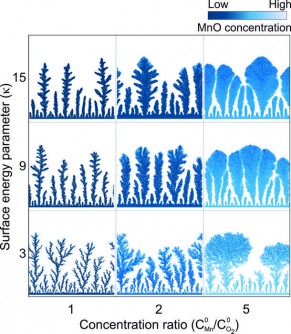Newswise — A team of international researchers, comprising scientists from the University of Vienna, the Faculty of Physics at the University of Warsaw, and the University of Edinburgh, has recently unveiled a breakthrough in understanding the growth mechanism of three-dimensional manganese dendrites. These unique structures were found to form through the accumulation of manganese oxide nanoparticles. This newfound comprehension of the dynamics behind the growth of mineral dendrites holds significant implications for various scientific disciplines, including physics, geology, material sciences, and the investigation of extraterrestrial environments. Not only does it provide invaluable insights into the origins of rocks and minerals, but it also offers potential applications in industry, such as the production of novel synthetic materials with enhanced properties.
When we contemplate minerals, we often envision flawless and symmetrical formations. Nevertheless, nature occasionally surprises us with more intricate and unconventional shapes. In a recent study, the growth dynamics of mineral dendrites were unveiled, unraveling the pioneering insights into their formation and the geological information they embody. This remarkable discovery challenges traditional pathways of crystallization and grants us a captivating glimpse into the intricate realm of mineral development. Unlike metallic or crystalline dendrites that arise from supercooled melts, mineral dendrites emerge as a consequence of unstable aqueous growth processes propelled by fluid motion and chemical concentration gradients. Specifically, manganese dendrites have been observed as two-dimensional structures on rock surfaces. However, until now, the mechanisms responsible for the growth of three-dimensional dendrites have largely remained a mysterious puzzle.
A team of researchers from multiple institutions investigated three-dimensional manganese (Mn) dendrites formed in clinoptilolite-tuffs, a type of volcanic tuff. By employing advanced imaging techniques and numerical modeling, they uncovered the hidden secrets within these intricate mineral formations. The researchers found that dendrite growth occurred through the accumulation of manganese oxide nanoparticles. These nanoparticles formed when manganese-rich fluids mixed with oxygenated pore-water, resulting in the development of complex dendritic structures. The geometry of these dendrites preserved the rock's hydro-geochemical history, including information about ion concentration, infiltrating fluid volume, and fluid pulses. This discovery highlights the dendrites' potential as geological fingerprints, capturing past environmental conditions. The study also revealed a non-classical crystallization pathway, challenging conventional notions of crystal growth and emphasizing the importance of particle attachment processes in nature. This finding aligns with the increasing recognition of this mechanism as a significant and widespread type of crystal growth.
Gaining an understanding of the growth dynamics of three-dimensional mineral dendrites carries significant implications across various scientific fields, including physics, geology, material science, and the study of extraterrestrial environments. This exploration opens up intriguing avenues for investigating the impact of microorganisms on the growth of MnO dendrites in extraterrestrial settings. By unraveling the intricate processes underlying their formation, scientists acquire valuable insights into the historical development of rocks and minerals. Moreover, this research serves as a foundation for further investigations into analogous dendritic formations, such as gold/electrum dendrites.
The study of three-dimensional Mn dendrites reveals a captivating realm of non-classical crystallization pathways and the concealed narratives preserved within geological structures. Through the integration of advanced imaging techniques and numerical modeling, scientists have made significant strides in unraveling the enigmatic nature of these intricate mineral formations. Professor Piotr Szymczak from the University of Warsaw's Faculty of Physics concludes, "As we delve deeper into the secrets of crystal growth, we unlock a greater understanding of Earth's history and the fascinating mechanisms at work in the natural world."
